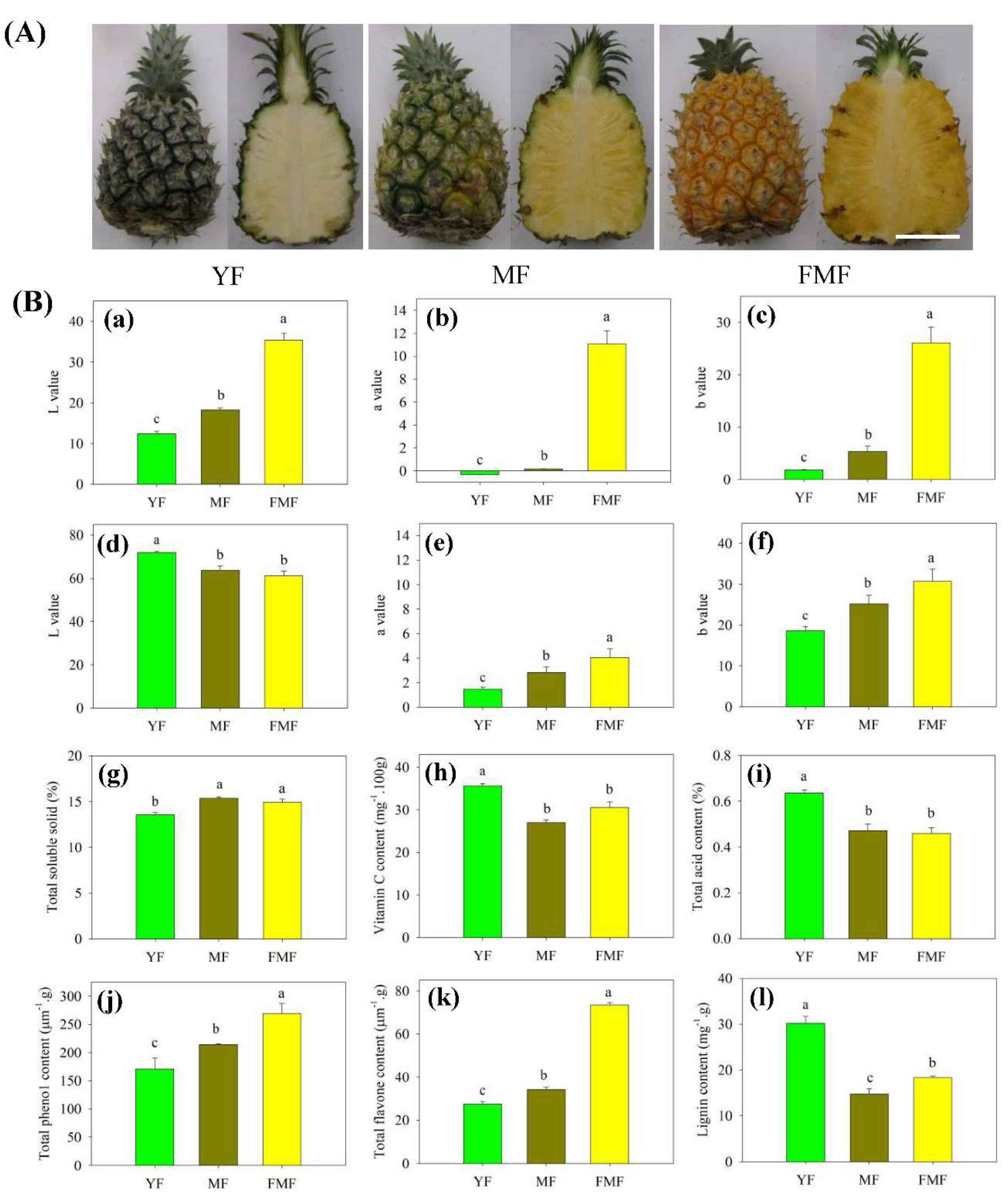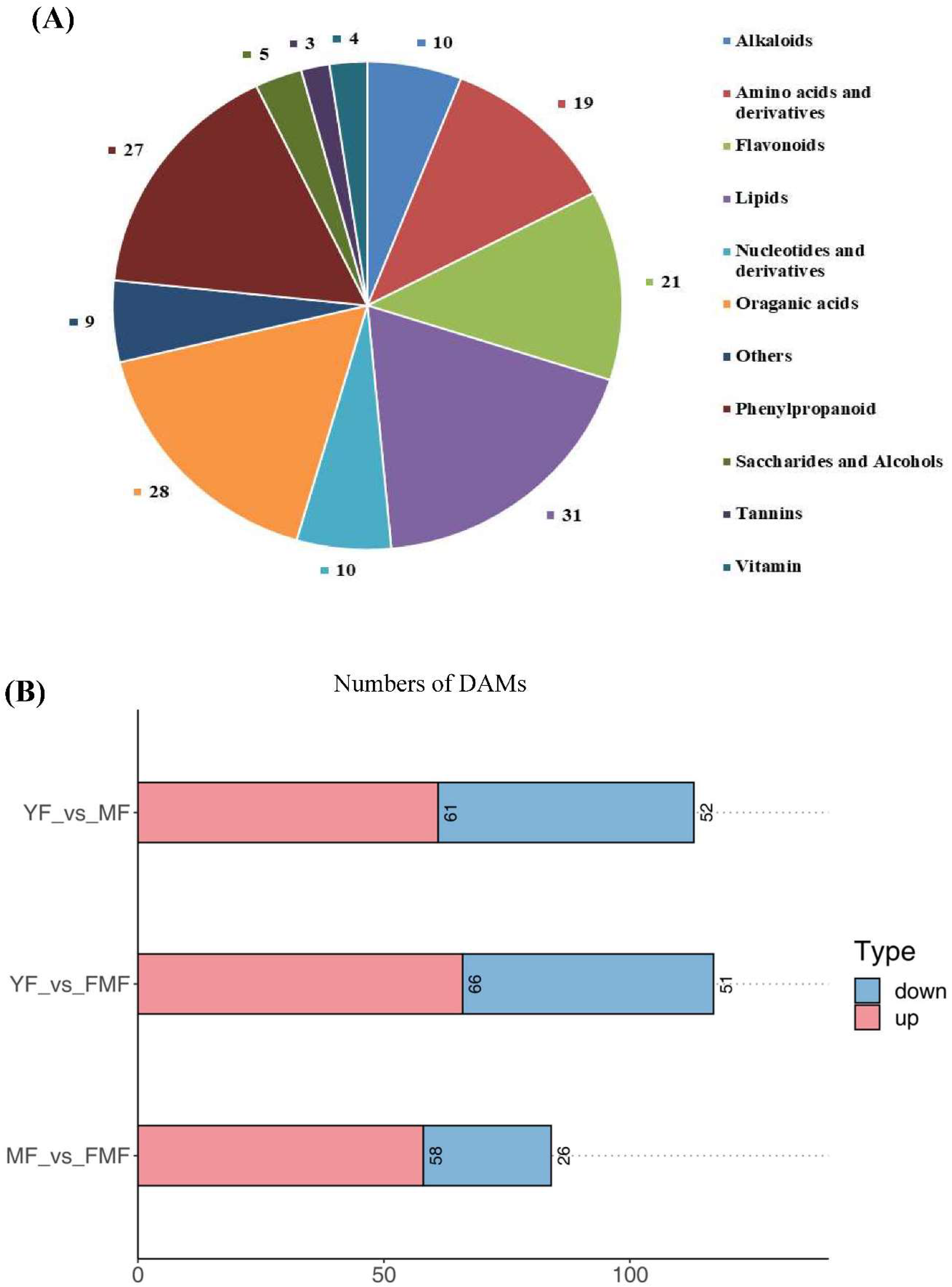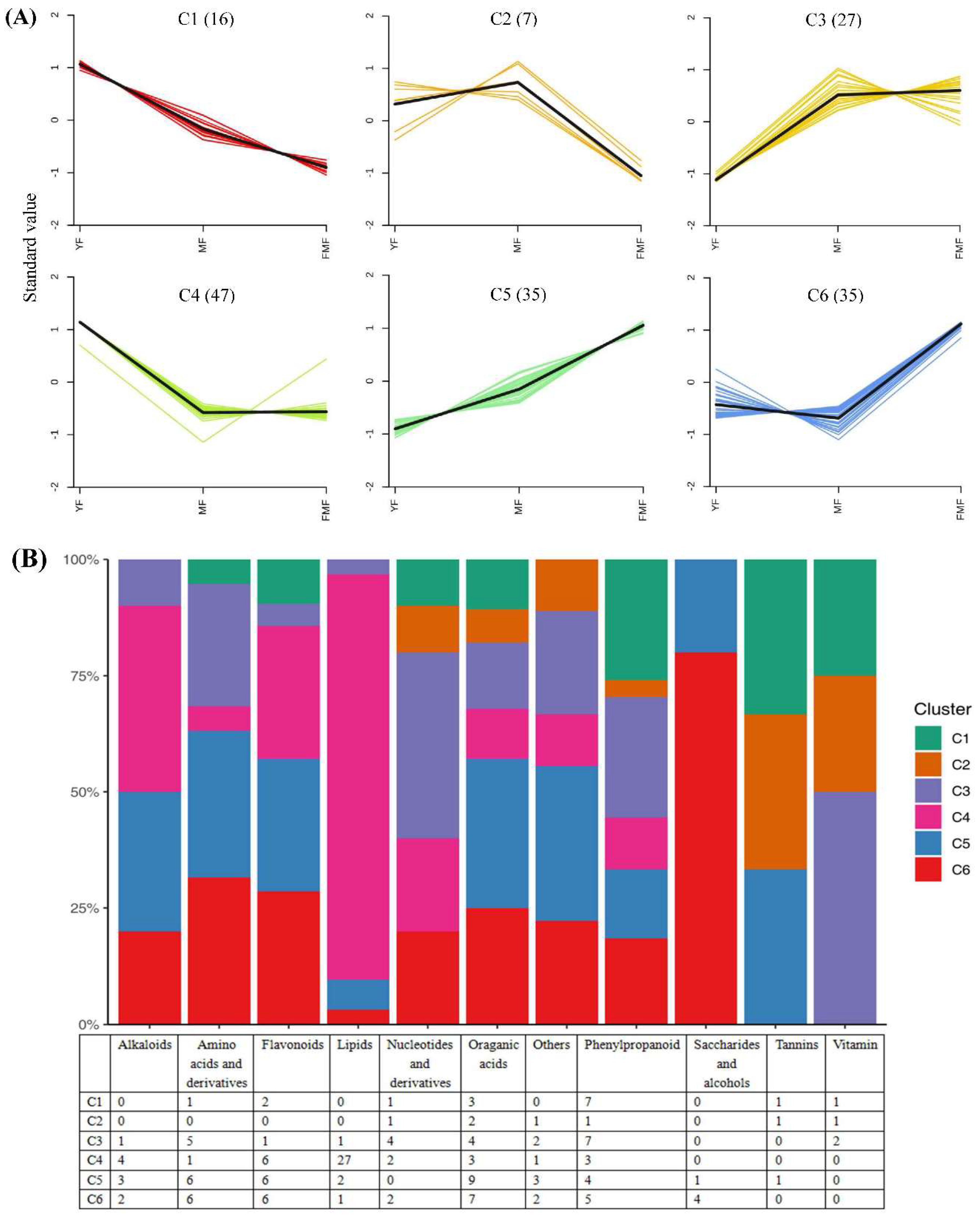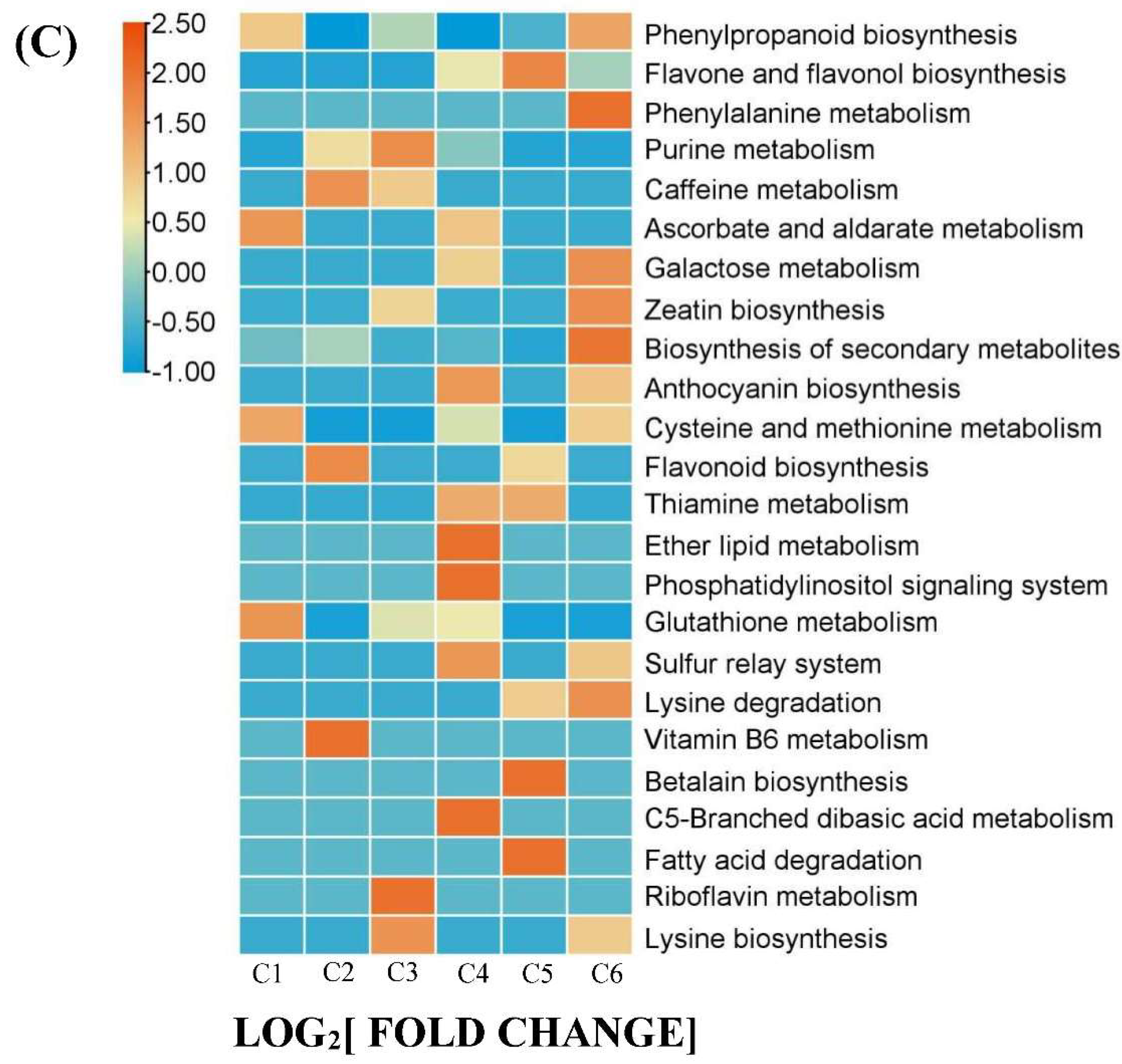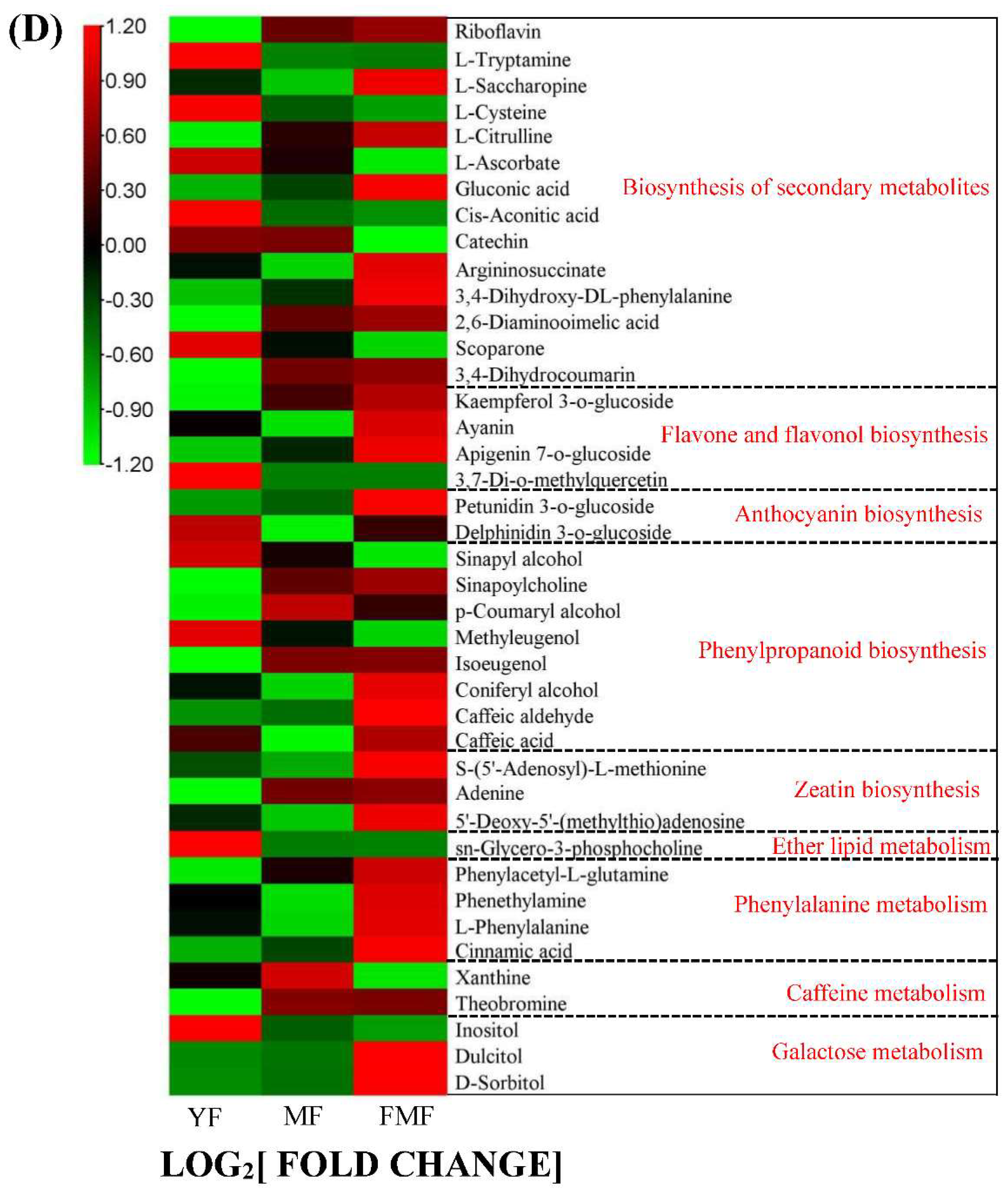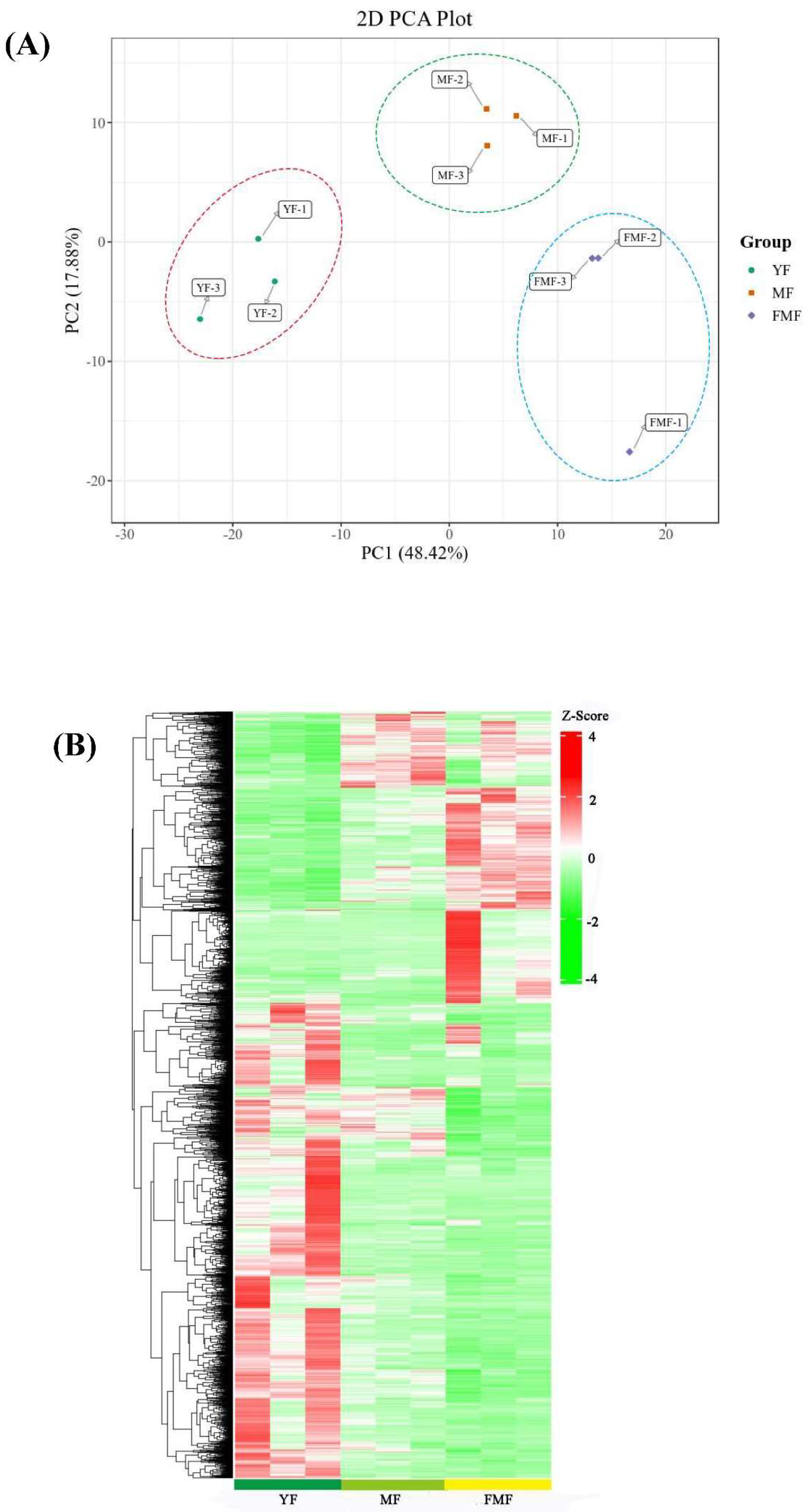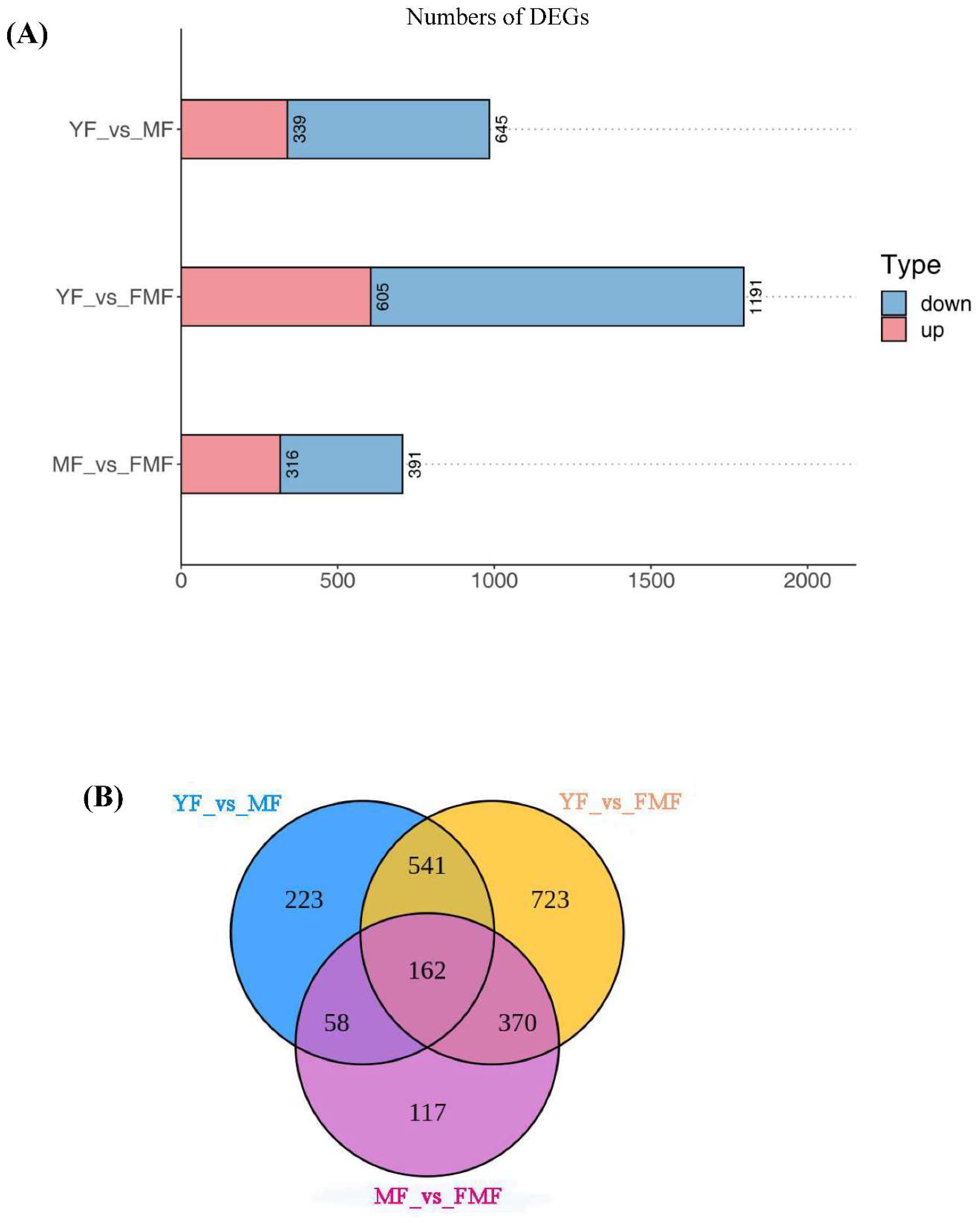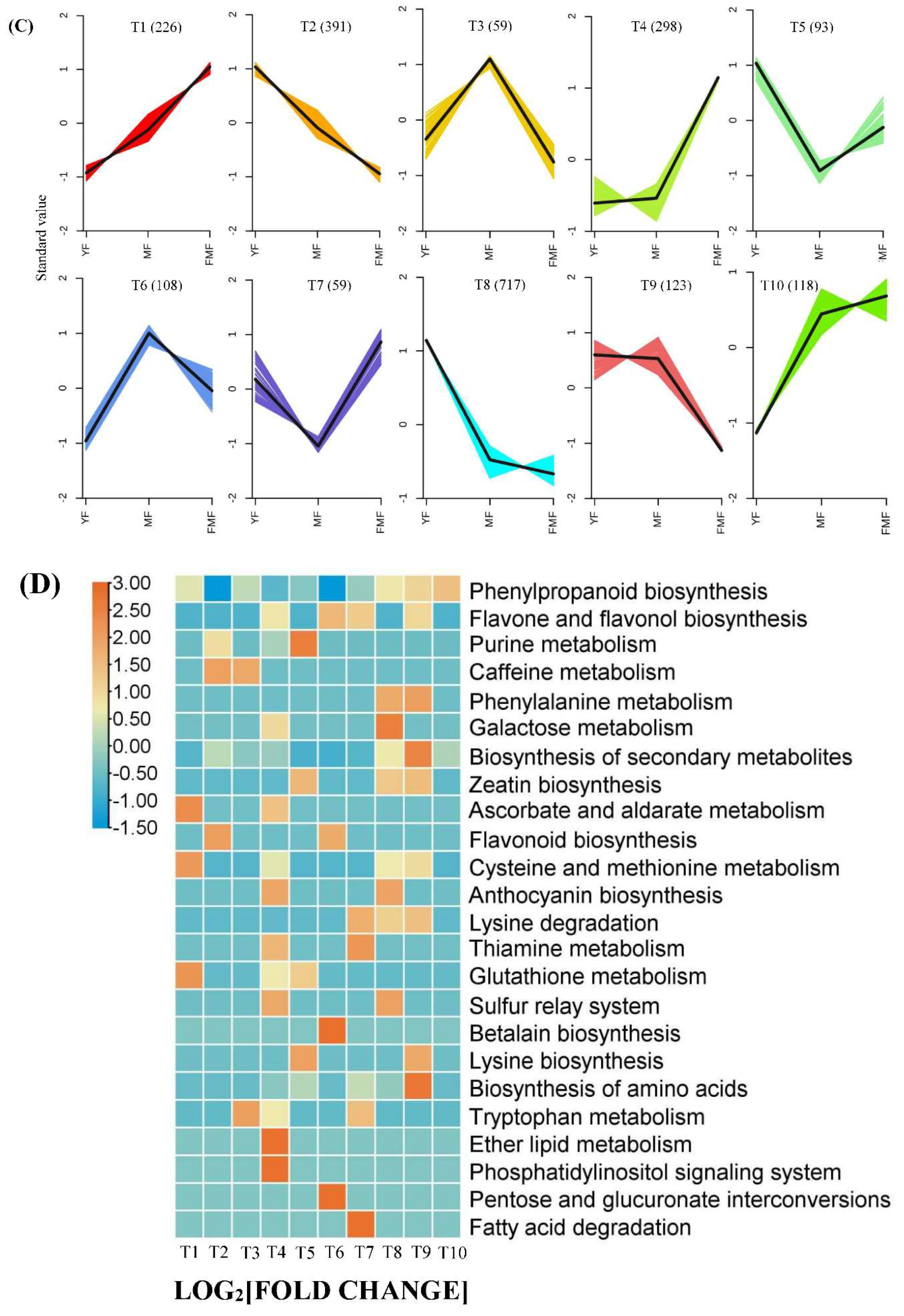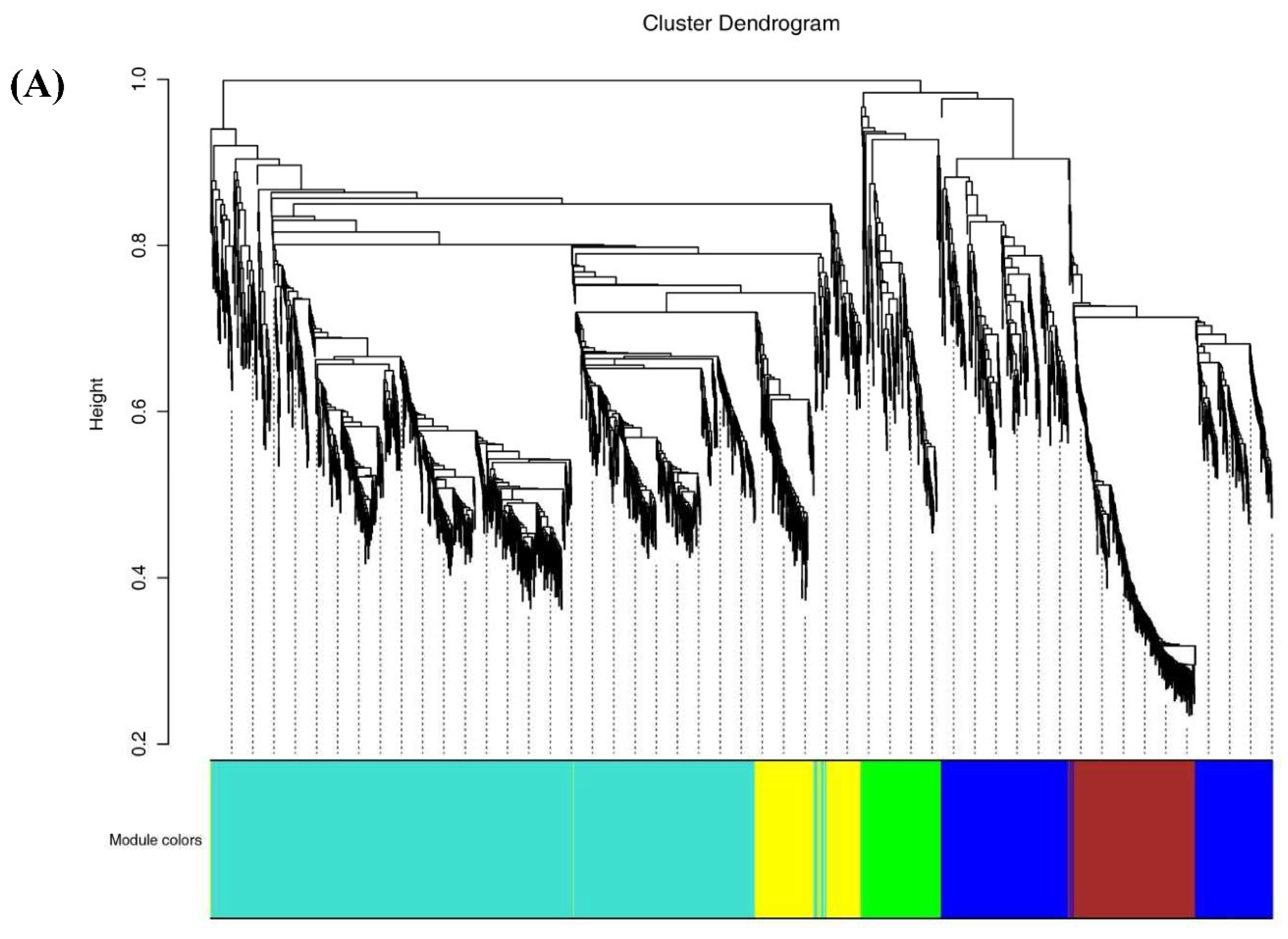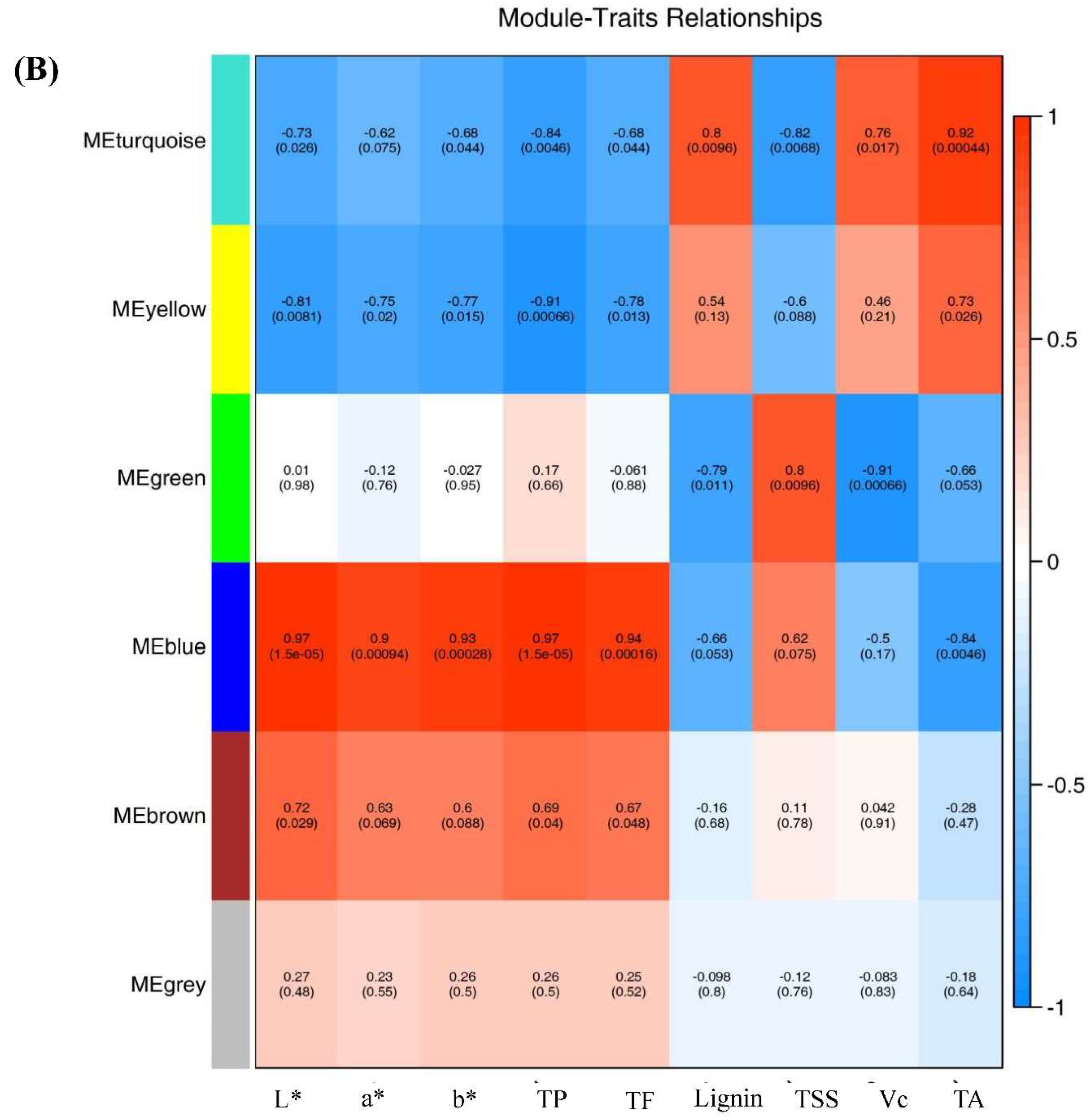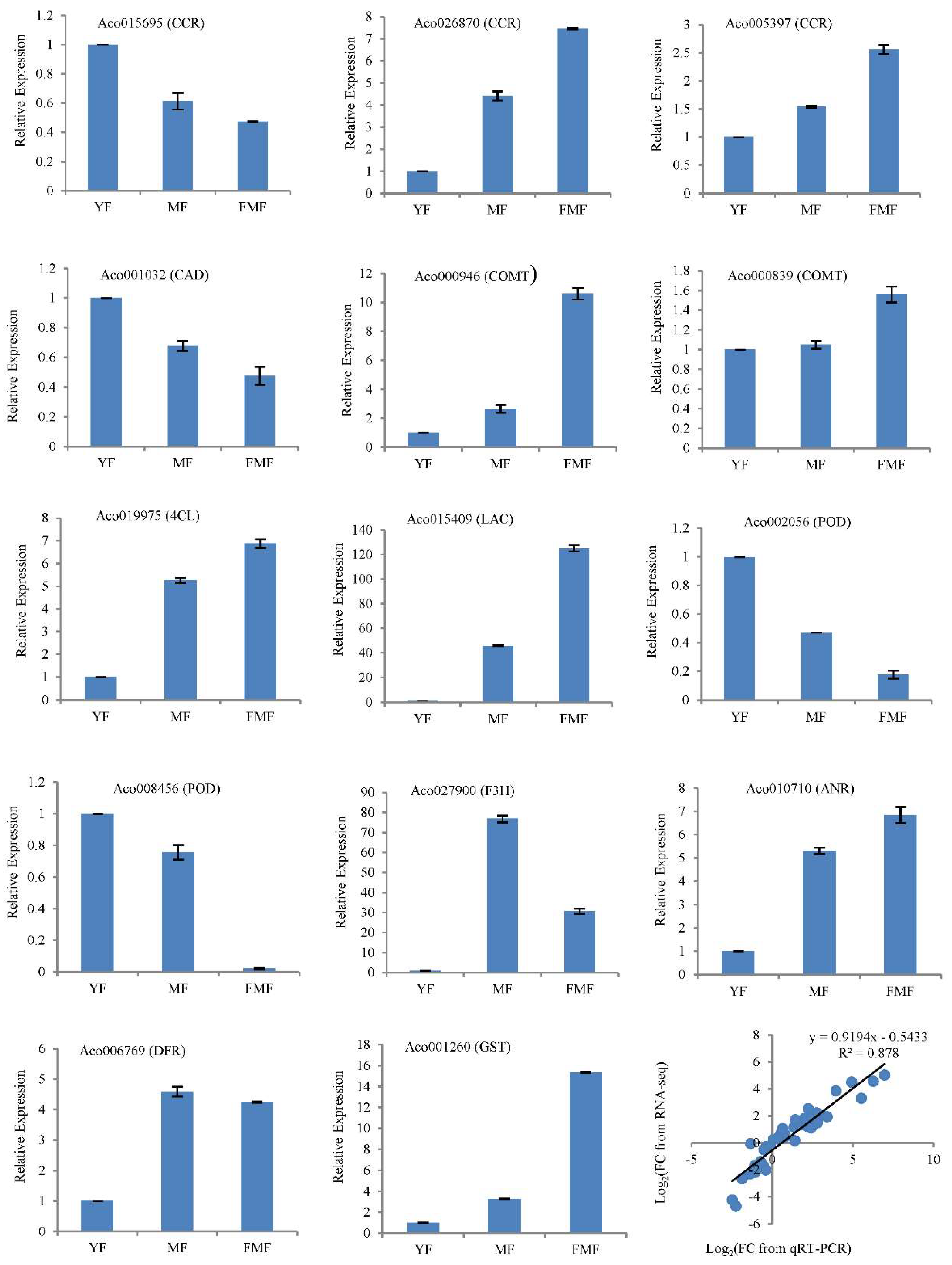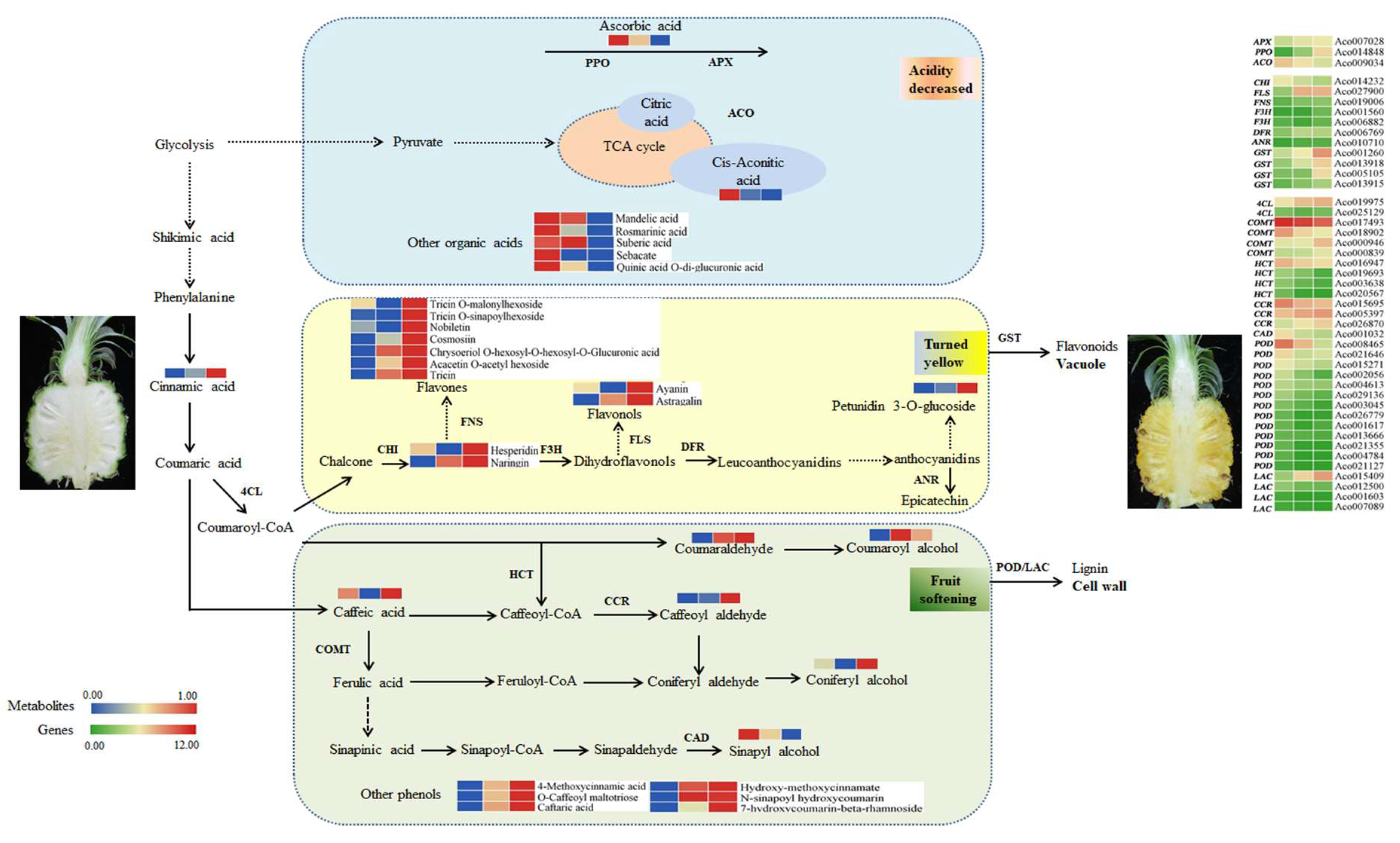1. Introduction
Pineapple (
Ananas comosus L. Merr.), a member of Bromeliaceae family, ranks as the third most commercially significant tropical and subtropical fruit globally, earning widespread acclaim for its nutrition value [
1,
2]. Biologically categorized as a non-climacteric species, pineapple does not undergo a post-ripening process and, post-harvest, progressively experiences a decline in quality acceptability. However, pineapple fruit ripening is accompanied by a gradual increase in respiration and ethylene release, resembling the behavior of climacteric fruits that undergo transformations in appearance, texture, and nutrient metabolism [
3,
4].
As aggregate fruit with a unique ripening profile, understanding the ripening characteristics of pineapple is important from both scientific and market perspectives. The transition in pulp color from white to yellow is believed to be a complex interplay of carotenoids and flavonoids, with flavonoids, notably flavonols, flavones, flavanols, anthocyanins, flavan-3-ols (catechins and proanthocyanidins) and phenolic acids, which are the predominant pigments [
5]. The texture of fleshy fruit, a pivotal quality attribute, not only constitutes a vital component of the primary cell wall polysaccharide but also significantly contributes to fruit hardness and overall edibility [
6]. Organic acids, which comprise diverse components, play a pivotal role in regulating fruit flavor. While some aspects of the content and alteration patterns of organic acids in pineapple fruit have been investigated in details [
7], questions remain regarding which components change as the fruit matures and ripeness processes.
Furthermore, the biosynthesis of phenylpropanoid and phenylpropanoid, along with organic acids metabolism, coincidentally, three crucial pathways responsive to oxidative stress, result in subsequent alterations in color, texture, and flavor, driven by the production of reactive oxygen species (ROS) during pineapple fruit ripening [
8,
9]. For instance, redox mechanisms have been identified as critical in the ripening of the Smooth Cayenne variety [
10]. Antioxidant compounds, such as flavonoids and polyphenols, have also been extensively investigated in various pineapple cultivars, including Smooth Cayenne, Red Spanish, MD-2 and Queen, during fruit ripening [
11,
12,
13,
14], underscoring the association between ROS derived from plant secondary metabolites and diverse ripening responses.
Despite prior investigations into alterations in cellular lipids, including lipid degradation and peroxidation, during fruit ripening in 'Comte de Paris' cultivar, the chief pineapple variety cultivated in China, little is known about the molecular events and metabolites involved in transformations associated with fruit yellowing, softening, and quality improvement during ripening [
15]. Therefore, the primary objective of this study was to examine ripening-related physicochemical parameters, including color, phenols, flavones, lignin, and quality. These findings were subsequently integrated with metabolomics and transcriptomics to elucidate the corresponding metabolites and genetic factors that govern fruit ripening. This comprehensive investigation is expected to significantly advance our understanding of the alterations in fruit color and quality during the fruit ripening process in 'Comte de Paris' pineapple, ultimately offering valuable insights for molecular breeding of the fruit.
3. Discussion
In recent decades, the maturation of pineapple fruit has garnered significant attention because of its complex ripening characteristics, which vary by variety and have considerable nutritional and commercial value [
10,
12,
13,
14]. Understanding the ripening characteristics of ‘Comte de Paris’ pineapple, the dominant cultivar in China, is crucial for regulating fruit quality and fostering the development of the local pineapple industry.
Fruit color, texture and taste are key indicators of fruit maturity and quality and are influenced by flavonoids, lignin, and organic acids [
16]. In our study, the changing patterns of a
* and b
* values in both the peel and the pulp closely mirrored the trends in total phenol and flavonoids contents during fruit ripening. This suggests that the observed pigment variations were primarily attributable to flavonoids and total phenols biosynthesis. Conversely, the TA and lignin contents displayed similar trends, all significantly decreased from the YF stage to the MF stage (
Figure 1). These findings suggest that the accumulation of flavonoids may contribute to pigment transition, which may be linked to the reduction in lignin content in cell walls, and organic acid degradation may explain the decrease in acidity during ripening. These observations are consistent with findings in other fruits, such as strawberries, papaya, and peaches [17,18,19].
To gain deeper insights into the metabolites associated with fruit ripening, we investigated variations in metabolites during pineapple fruit ripening. The pineapple fruit contains a variety of flavonoids that are closely linked to its color characteristics. The presence of pigments, especially flavonols and flavones, is believed to contribute to the pale-yellow pigmentation of pineapple fruit [
20,
21]. In our study, we observed significant increase in flavonols, such as ayanin and kaempferol 3-o-glucoside (astragalin), during fruit ripening, along with flavones, such as chrysoeriol 5-O-hexoside, chrysoeriol O-hexosyl-O-hexosyl-O-glucuronic acid, acacetin O-acetyl hexoside, apigenin 7-O-glucoside (cosmosiin), tricin O-malonylhexoside, tricin O-sinapoylhexoside, nobiletin. Additionally, other flavanones, including naringenin and hesperidin, as well as anthocyanin such as petunidin 3-O-glucoside, all exhibited continuous accumulation as fruit ripening progressed (
Figure 3;
Figure 8). These trends were consistent with the observed changes in fruit color and total flavonoids content. However, further research is needed to identify the specific components that contribute the most to yellow pigmentation.
Fruit texture is closely correlated with lignin content in the secondary cell wall [
22,
23]. In this study, we identified three lignin monomers in DAMs: sinapyl alcohol,
p-coumaryl alcohol, and coniferyl alcohol. Sinapyl alcohol exhibited a similar trend to lignin content, whereas
p-coumaryl alcohol and coniferyl alcohol displayed opposite trend. Concurrently, phenolic compounds, such as cinnamic acid and caffeic acid, derived from phenylpropanoid biosynthesis generally increased as fruit ripening progressed, consistent with the change in total phenolic content (
Figure 3). These findings suggested that these compounds play crucial roles in lignin and phenol biosynthesis.
A dramatic drop in organic acids content from YF to MF was observed in our study. Although the exact composition of the organic acids was not determined, previous research has indicated that citric acid is the predominant organic acid in mature pineapple fruit [
24,
25,
26]. In our study, we identified cis-aconitic acid, which is an intermediate in the conversion of citric acid to isocitric acid in the tricarboxylic acid cycle, as it significantly changes with fruit ripening. Ascorbic acid, which participates in the oxidative processes during fruit ripening, also decreases during fruit ripening advanced [
27]. Additionally, mandelic acid, rosmarinic acid, suberic acid, sebacate and quinic acid O-di-glucuronic acid were significantly decreased, suggesting that the reduction in TA may be attributed to the decreased content of these organic acids during pineapple fruit ripening.
Fruit ripening is a complex process involving various metabolic pathways, and reactive oxygen species (ROS) play a crucial role in ripening tropical and subtropical fruits [
4]. In the present study, we aimed to clarify the role of ROS in fruit ripening by investigating the pathways related to the biosynthesis of flavonoids, lignin, and the consumption of organic acids. Candidate genes associated with ripening characteristics, such as total flavonoids, total phenolic content, lignin, Vc, and TA, were identified using WGCNA.
The biosynthesis of flavonoid has been well-documented from a molecular genetic perspective [
28,
29]. Chalcone isomerase (CHI) catalyzes the conversion of colorless chalcones to flavanone (naringenin). In monocots, naringenin is further metabolized into flavones by flavone synthase (FNS), where F3H and flavonol synthase (FLS) are required for the synthesis of dihydroflavonols and flavonols [
30]. In some plant tissues such as fruits, DFR competitively reduces dihydroflavonols to leucoanthocyanidins, which are then converted to proanthocyanidins by ANR [
24]. GST is responsible for transferring anthocyanins, flavonols and flavones into the vacuole or cell wall for storage [
31,
32]. In our study, nine oxidoreductase genes including
FLS (Aco027900),
FNS (Aco019006),
F3H (Aco001560, Aco006882),
DFR(Aco006769),
ANR(Aco010710), and
GST (Aco001260, Aco013918, Aco005105, Aco013915), were identified by WGCNA (
Figure 6). These genes exhibited significantly and continuously increasing expression during fruit ripening, correlating with the accumulation of flavones and flavonols, which contribute to pigment formation.
Phenylpropanoid metabolism is closely associated with lignin biosynthesis. In this pathway, 4-Coumaroyl CoA Ligase (4CL) catalyzes the formation of activated thioesters of hydroxycinnamic acids, which enter different branch pathways of phenylpropanoid metabolisom [
33]. Hydroxycinnamoyl CoA: shikimate hydroxycinnamoyl transferase (HCT) is a key metabolic entry point for the synthesis of essential lignin monomers, coniferyl and sinapyl alcohols, particularly in monocotyledonous plant [
34]. COMT methylates caffeic acid to ferulic acid, whereas CCR and CAD convert CoA ester to alcohol during monolignol biosynthesis. These monolignols are exported to the cell wall and polymerized into lignin by POD or depolymerized by LAC [
35,
36]. In our study, four hydroxycinnamoyl transferase (HCT) genes were downregulated during fruit ripening, consistent with the accumulation of
p-coumaryl alcohol and the reduction of lignin monomers, coniferyl, and sinapyl alcohols. The expression of screened
COMT (Aco017593, Aco018902),
CCR (Aco015695), and
CAD (Aco001032) genes generally showed a decreasing trend, in line with the accumulation of intermediate phenolic metabolites such as caffeic acid and caffeoyl aldehyde. Additionally, identified
POD genes (Aco008465, Aco021646, Aco015271, Aco002056, Aco004613, Aco029136, Aco003045, Aco026779, Aco001617, Aco013666, Aco021355, Aco004784, Aco021127) and the
LAC gene (Aco015409) were downregulated during fruit ripening (
Figure 8), indicating their potential role in the depolymerization of lignin in the cell wall as fruit ripening progressed.
Ascorbic acid is known to be oxidized to dehydroascorbic acid during fruit ripening, a process catalyzed by ascorbic acid oxidase (APX) [
10,
27,
37]. In our study, genes related to
APX (Aco007028), and polyphenol oxidase (
PPO, Aco014848) exhibited consistently increasing expression as fruit ripening progressed, suggesting their involvement in the oxidation of ascorbic acid. Cis-aconitic acid, an organic acid is catalyzed by the aconitase (ACO), which converts citric acid to isocitric acid [
38]. In our study, the expression of
ACO (Aco009034) gradually decreased (
Figure 8), suggesting its potential role in the reduced accumulation of cis-aconitic acid during pineapple fruit.
Based on these findings, we propose a schematic overview to elucidate the metabolites and corresponding genes involved in pineapple fruit ripening (
Figure 8). Further research is required to fully understand the regulatory mechanisms underlying these processes.
4. Materials and methods
4.1. Plant Materials and Sampling
Pineapple (
Ananas comosus cv. 'Comte de Paris') fruits, carefully selected for their absence of defects and mechanical damage, were procured from a commercial orchard in Xuwen county (20°34′N; 110°17′E), Zhanjiang city, Guangdong province, China, in September 2018. These fruits were swiftly transported to the laboratory within a two-hour timeframe. A total of 120 fruits were used in this experiment, meticulously chosen to represent three distinct stages of maturity: young fruit (YF), mature fruit (MF) and fully mature fruit (FMF), with 40 fruits allocated to each stage. The definition of maturity stage followed the criteria established in our previous study [
15]. To ensure robustness, three replicate samples were meticulously prepared for each biological sample, with 12 fruits sampled from each replicate to assess the physiological parameters. Fruit pulp weighing 20.0 grams was collected following the methodology outlined in our previous work [
39] and stored at -80 ℃ for subsequent assessments.
4.2. Evaluation of the Color Changes of Fruit
The color-related parameters, including L* (presenting lightness), a* (indicating the transition from green to red), and b* (indicating the shift from blue to yellow) were measured using a high-precision colorimeter (HP-C210, Shanghai, China). To assess L*, a* and b*, at least nine fruits at each ripening stage were halved longitudinally along the equator of the peel and pulp. At this juncture, three distinct points were selected for each parameter and readings for L*, a*, and b* were recorded. For each pineapple, three readings were captured for each color-related parameter, ensuring robust and reliable measurements.
4.3. Measurements of Contents of Soluble Solids, Titratable Acid, and Vitamin C in Pulp
The total soluble solids content (TSS) was analyzed using a handheld PAL-1(B625333) device, and the values were expressed in degree Brix.
For titratable acid (TA) determination, we followed the acid-base titration method outlined by Li et al. [
40]. Briefly, 3 grams of frozen pulp power was dissolved in 30 mL distilled water and then heated to 80 ℃ for 30 min. After centrifugation at 4000 ×
g for 15 min, 10 mL of the supernatant was titrated with 0.1 mol L
-1 NaOH, and the titration volume was recorded. The resulting data are expressed as the percentage of citric acid.
To determine the Vitamin C (Vc) content, we employed a titration method utilizing 2, 6-dichlorophenol indophenols following the procedure described by Hou et al. [
41]. In short, 3 grams of frozen pulp tissue was ground in 25 mL of 2% oxalic acid solution on ice, followed by centrifugation at 4000 ×
g at 4 ℃ for 15 min. The supernatant was then titrated with 2,6-dichlorophenol indophenol, and the results were expressed as grams per kilogram (g kg
-1) of fresh weight (FW).
4.4. Extractions and Assays of Contents of Total Phenolic, Total Flavonoids and Lignin in Pulp
The total phenolic content was determined using the Folin-Ciocalteu method, as outlined in Zhou et al. [
42], with slight modification. In brief, 0.5 grams of frozen pulp tissue was homogenized in 80% (v/v) methanol for 2 h and subsequently centrifuged at 10, 000 × g for 15 min. The supernatant solution was collected for the analysis of total phenolic and flavonoids contents. A mixture consisting of 0.5 mL supernatant, 2 mL of Folin-Ciocalteu reagent, and 2 mL of 7.5% (w/v) Na
2CO
3 was incubated at 50 ℃ for 5 min. The absorbance was measured at 760 nm and the results were expressed as grams of gallic acid equivalent per kilogram (g of gallic acid equivalent kg
-1) of FW.
Total flavonoids content was determined using the aluminum nitrate method, as described by Zhou et al. [
42]. In summary, 3 mL of supernatant, 0.5 mL 5% (w/v) NaNO
2 and 0.5 mL 10% (w/v) AlNO
3 were mixed. After 5 min, 1 mL of 1 mol L
-1 NaOH was added. The absorbance was measured at 510 nm and the results were calculated based on a standard curve and defined as g rutin kg
-1 FW.
To determine lignin content, a modified version of the procedure described by Morrison [
43] was employed. Approximately 5 grams of pulp tissues powder was mixed with 95% pre-cooled ethanol, then centrifuged at 12,000 × g for 30 min at 4 ℃, and this process four times. Sediment was collected and dried overnight at 70 ℃. Subsequently, 0.1 grams of residue was dissolved in 1 mL of 25% (v/v) acetyl bromine-acetic acid, and the solution was incubated at 70 ℃ for 30 min. After cooling on ice, the reaction was terminated with 1 mL of 2 mol L
-1 NaOH, followed by addition 2 mL of glacial acetic acid and 0.1 mL of 7.5 mol L
-1 hydroxylamine hydrochloride (7.5 mL). After centrifugation at 12,000 × g and 4 ℃ for 10 min, the absorbance was measured at 280 nm. The lignin content was then calculated against the standard curve and expressed as g.kg-1 of FW.
4.5. RNA Extraction, Illumine Sequencing and Transcriptomics Data Analysis
Total RNA was meticulously extracted from pulp tissues representing three distinct ripening stages, following the manufacturer’s instructions, using a Quick RNA isolation kit (Huayueyang, China). RNA quality was comprehensively assessed using a 2100 Bioanalyzer RNA Nanochip (Agilent, USA). To confirm RNA integrity, electrophoresis was performed on formaldehyde-containing 1.5% (w/v) agarose gels.
For library preparation, all procedures were performed in strict accordance with the manufacturer’s guidelines provided with the Truseq2 RNA sample prep Kit from Illumina, Inc. San Diego, CA, USA. Raw data were acquired using the Illumina HiSeq TM2000 platform and subsequently aligned to the pineapple reference genome using HISAT2.
To identify differentially expressed genes (DEGs) among samples, transcript abundance was estimated using the fragments per kilobase of exon per million mapped reads method. Statistically significant DEGs were identified based on the criteria of False Discovery Rate (FDR) ≤ 0.05, |log2ratio| ≥ 1. K-means cluster analysis was carried out using the R package, and enrichment analysis of DEGs was performed using a hypergeometric distribution test. Gene expression patterns were visualized and presented using TBtools.
4.6. Weighted Gene Co-expression Network Analysis and Gene Network Visualization
A total of 2194 DEGs were employed to construct unsigned co-expression networks using the Weighted Gene Co-expression Network Analysis (WGCNA) tool, version 1.69 [
44]. The followings parameters were applied: the power of 14, maximum module size of 5000, minimum module size of 30, and merge height of 0.25. For each module, the eigengene value was calculated and subsequently used to assess correlations with ripening properties including L
*, a
*, b
*, total phenolic content, total flavonoid content, lignin content, TSS, Vc content, and TA. The co-expression diagram was visually represented using Cytoscape, version 3.8.1.
4.7. Quantitative Real-Time PCR (RT-qPCR) Verification
Fourteen candidate genes involved in the biosynthesis of flavonoids and lignin were selected randomly for verification using RT-qPCR, with three biological replicates.
Acactin (HQ148720) was used as an endogenous reference gene, and gene-specific primer sequences are shown in Supplemental Table 1. The relative expression of these candidate genes was determined using the 2
-△△CT method following the approach outlined by Livak and Schmittgen [
45].
4.8. Statistics
Statistics analysis was performed using one-way analysis of variance (ANOVA) with SPSS (version 16.0, Chicago, IL, USA). Data are presented as the mean + standard error derived from three independent replicates. Statistically significant differences were assessed using the least significant difference test, with the significance set at P < 0.05.
5. Conclusion
The data presented in this study revealed significant changes in pineapple ripening, including the development of yellow pigment, softening of the fruit, a decrease in acidity. Metabolomic analyses have provided insights into the underlying mechanisms responsible for these changes. Specifically, the observed phenomenon can be attributed to the following:
Increased Accumulation of Flavonoids: The ripening process is associated with a notable increase in flavonoid content, including ayanin, kaempferol 3-o-glucoside, chrysoeriol 5-O-hexoside, chrysoeriol O-hexosyl-O-hexosyl-O-glucuronic acid, acacetin O-acetyl hexoside, apigenin 7-O-glucoside, tricin O-malonylhexoside, tricin O-sinapoylhexoside, nobiletin, naringenin and hesperidin.
Reduction of Lignin: Lignin content decreases during ripening, with sinapyl alcohol identified as a significant component involved in this process.
Degradation of Organic Acids: The levels of various organic acids, including cis-aconitic acid, mandelic acid, rosmarinic acid, suberic acid, sebacate and quinic acid O-di-glucuronic acid, decreased as the fruit ripened.
Furthermore, the integration of metabolomic and transcriptomic data has identified a series of putative candidate genes associated with the metabolism of flavonoids, lignin and organic acids. These candidate genes included the following:
Flavonoid Metabolism:
FLS (Aco027900), FNS (Aco019006), F3H (Aco001560, Aco006882), DFR(Aco006769), ANR(Aco010710), and GST (Aco001260, Aco013918, Aco005105, Aco013915).
Lignin Metabolism:
COMT (Aco017593, Aco018902), CCR (Aco015695), CAD (Aco001032), POD genes (Aco008465, Aco021646, Aco015271, Aco002056, Aco004613, Aco029136, Aco003045, Aco026779, Aco001617, Aco013666, Aco021355, Aco004784, Aco021127), and LAC (Aco015409).
Organic acid Metabolism:
APX (Aco007028), PPO (Aco014848), and ACO (Aco009034).
These identified genes are inferred to play crucial roles in regulating the changes in fruit color and quality during pineapple ripening. The insights gained from this study will contribute to better understanding of the molecular mechanisms underlying these ripening processes. This knowledge can serve as a scientific foundation for genetic breeding efforts aimed at improving pineapple fruit quality.
Figure 1.
The changes of appearance and quality traits of pineapple fruit at three distinct stages of maturity: YF, MF, and FMF, respectively. (A) Appearance images of fruit during ripening. (B) Change in L*, a*, b*, TSS, Vc content, TA, total phenolic content, total flavonoid content, and lignin content during ripening. Data are presented as the mean + standard error derived from three independent replicates. Bars with different lower-case letters indicate significant differences based on a t-test at the P ≤ 0.05 level. Scale bar = 8 cm.
Figure 1.
The changes of appearance and quality traits of pineapple fruit at three distinct stages of maturity: YF, MF, and FMF, respectively. (A) Appearance images of fruit during ripening. (B) Change in L*, a*, b*, TSS, Vc content, TA, total phenolic content, total flavonoid content, and lignin content during ripening. Data are presented as the mean + standard error derived from three independent replicates. Bars with different lower-case letters indicate significant differences based on a t-test at the P ≤ 0.05 level. Scale bar = 8 cm.
Figure 2.
Analysis of 167 differentially accumulated metabolites (DAMs). (A) Pie chart of identified the types and quantities of metabolites. (B) The red and blue bars indicate the number of upregulated and downregulated DAMs between YF and MF, YF and FMF, MF and FMF, respectively.
Figure 2.
Analysis of 167 differentially accumulated metabolites (DAMs). (A) Pie chart of identified the types and quantities of metabolites. (B) The red and blue bars indicate the number of upregulated and downregulated DAMs between YF and MF, YF and FMF, MF and FMF, respectively.
Figure 3.
Overview of 167 DAMs. (A) 6 clusters of K-means (Designated C1-C6). (B) The distribution of different substance categories in the 6 clusters. The table below the histogram shows the number of each type of metabolites of different clusters. (C) KEGG enrichment analysis for DAMs among the 6 clusters. (D) The top of 10 pathways clustering analysis on the change trends of DAMs profiles in pineapple fruit from YF, MF, and FMF groups.
Figure 3.
Overview of 167 DAMs. (A) 6 clusters of K-means (Designated C1-C6). (B) The distribution of different substance categories in the 6 clusters. The table below the histogram shows the number of each type of metabolites of different clusters. (C) KEGG enrichment analysis for DAMs among the 6 clusters. (D) The top of 10 pathways clustering analysis on the change trends of DAMs profiles in pineapple fruit from YF, MF, and FMF groups.
Figure 4.
Analysis of 2094 differentially expressed genes (DEGs). (A) Principal component analysis (PCA) on the RNA-seq data. (B) Hierarchical clustering analysis (HCA) of the DEGs in pineapple fruits at YF, MF, and FMF, respectively. Each gene is represented by a single row.
Figure 4.
Analysis of 2094 differentially expressed genes (DEGs). (A) Principal component analysis (PCA) on the RNA-seq data. (B) Hierarchical clustering analysis (HCA) of the DEGs in pineapple fruits at YF, MF, and FMF, respectively. Each gene is represented by a single row.
Figure 5.
Overview of pineapple fruit transcriptome. (A) The red and blue bars indicate the number of upregulated and downregulated DEGs between YF and MF, YF and FMF, MF and FMF, respectively. (B) Venn diagrams illustrating the overlap of DEGs revealed by paired comparion between between YF and MF, YF and FMF, MF and FMF, respectively. (C) 10 clusters of K-means (Designated T1-T10). (D) KEGG enrichment analysis for DEGs among the 10 clusters.
Figure 5.
Overview of pineapple fruit transcriptome. (A) The red and blue bars indicate the number of upregulated and downregulated DEGs between YF and MF, YF and FMF, MF and FMF, respectively. (B) Venn diagrams illustrating the overlap of DEGs revealed by paired comparion between between YF and MF, YF and FMF, MF and FMF, respectively. (C) 10 clusters of K-means (Designated T1-T10). (D) KEGG enrichment analysis for DEGs among the 10 clusters.
Figure 6.
Correlations of 2194 DEGs with physiological indexes based on Weighted Gene Co-expression Network Analysis (WGCNA). (A). Clustering dendrogram showing 6 modules of co-expressed genes by WGCNA. (B). Module-trait relationships. Each row corresponds to a module, and each column corresponds to a quality characteristic trait. Notes: L*, L* value; a*, a* value; b*, b* value; TP, total phenols content; TF, total flavones content; TSS, total soluble solid; Vc, vitamin C content; TA, total acid.
Figure 6.
Correlations of 2194 DEGs with physiological indexes based on Weighted Gene Co-expression Network Analysis (WGCNA). (A). Clustering dendrogram showing 6 modules of co-expressed genes by WGCNA. (B). Module-trait relationships. Each row corresponds to a module, and each column corresponds to a quality characteristic trait. Notes: L*, L* value; a*, a* value; b*, b* value; TP, total phenols content; TF, total flavones content; TSS, total soluble solid; Vc, vitamin C content; TA, total acid.
Figure 7.
Verification of the RNA-seq data by RT-qPCR in 14 candidate genes involved in the biosynthesis of flavonoids and lignin. Notes: FC, fold change.
Figure 7.
Verification of the RNA-seq data by RT-qPCR in 14 candidate genes involved in the biosynthesis of flavonoids and lignin. Notes: FC, fold change.
Figure 8.
Dynamics of metabolites and genes related to the pineapple fruit ripening. Notes: Three blocks represent YF, MF, and FMF, respectively. SPS, sucrose phosphate synthase; APX, ascorbates peroxidase; ACO, aconitase; PPO, polyphenol oxidase; 4CL, p-coumarate: CoA ligase; CAD, cinnamyl alcohol dehydrogenase; CCR, Cinnamoyl CoA reductase; COMT, caffeic acid O-methyl transferase; HCT, hydroxycinnamoyltransferase; POD, peroxidase; LAC, laccase; CHI, chalcone isomerase; F3H, Flavanone 3-Hydroxylase; DFR, dihydroflavonol-4-reductase; ANR, anthocyanidin reductase; LDOX, leucoantho-cyanidin dioxygenase; GST, glutathione transferases.
Figure 8.
Dynamics of metabolites and genes related to the pineapple fruit ripening. Notes: Three blocks represent YF, MF, and FMF, respectively. SPS, sucrose phosphate synthase; APX, ascorbates peroxidase; ACO, aconitase; PPO, polyphenol oxidase; 4CL, p-coumarate: CoA ligase; CAD, cinnamyl alcohol dehydrogenase; CCR, Cinnamoyl CoA reductase; COMT, caffeic acid O-methyl transferase; HCT, hydroxycinnamoyltransferase; POD, peroxidase; LAC, laccase; CHI, chalcone isomerase; F3H, Flavanone 3-Hydroxylase; DFR, dihydroflavonol-4-reductase; ANR, anthocyanidin reductase; LDOX, leucoantho-cyanidin dioxygenase; GST, glutathione transferases.
